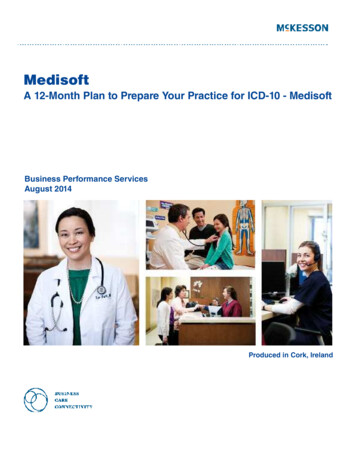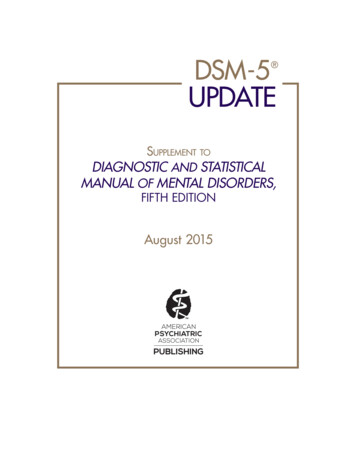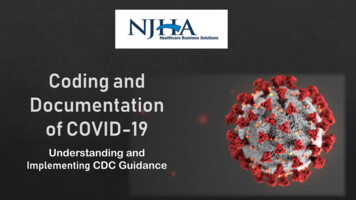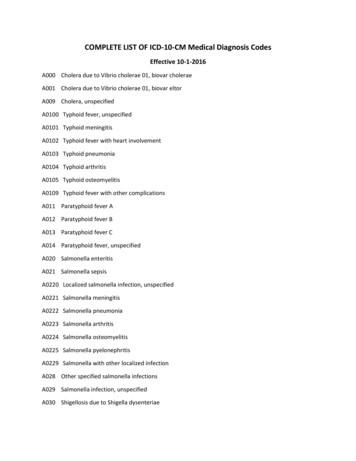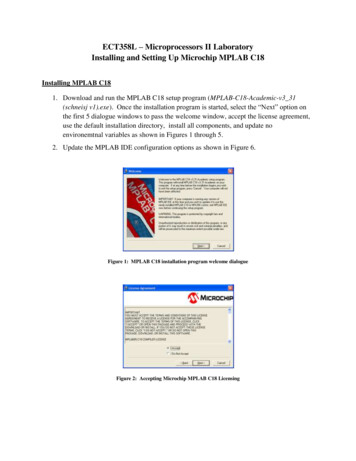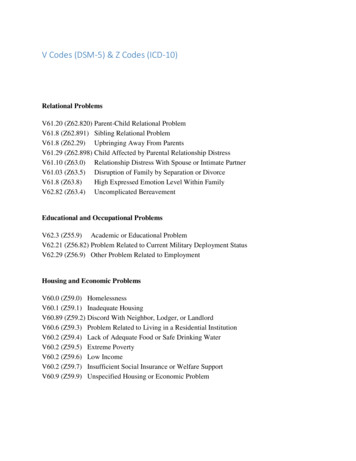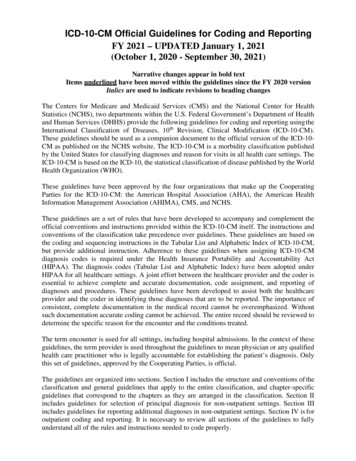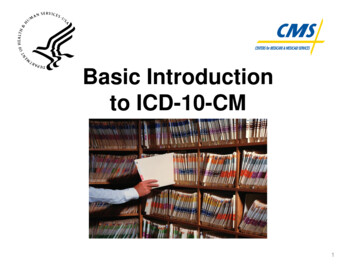
Transcription
Basic Introductionto ICD-10-CM1
Pat Brooks, RHIASenior Technical AdvisorHospital and Ambulatory Policy Group (HAPG)Center for Medicare Management (CMM)Centers for Medicare & Medicaid Services(CMS)Patricia.brooks2@cms.hhs.gov2
ICD-10 Final RuleCMS-0013-F Published January 16, 2009 October 1, 2013 – Compliance date forimplementation of ICD-10-Clinical Modification(CM) and ICD-10-Procedure Coding E9-743.pdf3
ICD-10 Implementation Single implementation date for all users– Date of service for ambulatory and physicianreporting– Date of discharge for inpatient settings ICD-9-CM codes will not be accepted forservices provided on or after October 1, 2013 ICD-9-CM claims for services prior toimplementation date will continue to flow throughsystems for a period of time No grace period4
Sue Bowman, RHIA, CCSDirector, Coding Policy and ComplianceAmerican Health Information ManagementAssociation (AHIMA)Sue.bowman@ahima.org5
Benefits of ICD-10-CM Up-to-date classification systems will provide muchbetter data for:– Measuring the quality, safety, and efficacy of care– Designing payment systems and processing claims forreimbursement– Conducting research, epidemiological studies, and clinicaltrials– Setting health policy– Operational and strategic planning and designinghealthcare delivery systems– Monitoring resource utilization– Improving clinical, financial, and administrative performance– Preventing and detecting healthcare fraud and abuse– Tracking public health and risks6
ICD-10-CM StructureICD-9-CM 3 - 5 characters First character is numericor alpha (E or V) Characters 2- 5 arenumeric Always at least 3characters Use of decimal after 3charactersICD-10-CM 3 - 7 characters Character 1 is alpha (allletters except U are used) Character 2 is numeric Characters 3 - 7 are alpha ornumeric Use of decimal after 3characters Use of dummy placeholder “x” Alpha characters are notcase-sensitive7
ICD-9-CM Structure – Format3 - 5 Characters496414 .00V 55.3 Codes longer than 3 characters always havedecimal point after first 3 characters 1st character: alpha or numeric 2nd through 5th characters: numeric8
ICD-10-CM Structure – Format3 - 7 CharactersP09S32.010AO9A.211M1A.0111 Codes longer than 3 characters always have decimal pointafter first 3 characters 1st character: alpha 2nd through 7th characters: alpha or numeric 7th character used in certain chapters (obstetrics,musculoskeletal, injuries, and external causes of injury)9
ICD-10-CM: Similaritiesto ICD-9-CM Format– Tabular List and Index Chapters in Tabular structured similarly to ICD9-CM, with minor exceptions– A few chapters have been restructured– Sense organs (eye and ear) separated from NervousSystem chapter and moved to their own chapters Index structured the same as ICD-9-CM––––Alphabetic Index of Diseases and InjuriesAlphabetic Index of External CausesTable of NeoplasmsTable of Drugs and Chemicals10
ICD-10-CM: Similaritiesto ICD-9-CM Divided into Alphabetic Index andTabular List– Structure and format are the same– Index is alphabetical list of terms and theircorresponding codes Alphabetic Index lists main terms in alphabeticalorder with indented subterms under main terms Index is divided into 2 parts: Index to Diseasesand Injuries and Index to External Causes11
ICD-10-CM: Similaritiesto ICD-9-CM Tabular List is a chronological list of codesdivided into chapters based on body system orcondition Tabular List is presented in code number order Same hierarchical structure Codes are invalid if they are missing anapplicable character Codes are looked up the same way– Look up diagnostic terms in Alphabetic Index– Then verify code number in Tabular List12
ICD-10-CM: Similaritiesto ICD-9-CM Many conventions have same meaning– Abbreviations, punctuation, symbols, notessuch as “code first” and “use additional code” Nonspecific codes (“unspecified” or “nototherwise specified”) are available to usewhen detailed documentation to supportmore specific code is not available13
ICD-10-CM: Similaritiesto ICD-9-CM ICD-10-CM Official Guidelines for Codingand Reporting accompany and complementICD-10-CM conventions and instructions Adherence to the official coding guidelinesin all healthcare settings is required underthe Health Insurance Portability andAccountability Act14
ICD-10-CM: Differencesfrom ICD-9-CM All codes are alphanumeric– 1st character is always alpha and alpha charactersmay appear elsewhere in the code as well Codes can be up to 7 characters in length Codes are more specific Code titles are more complete (no need to referback to a category, subcategory, orsubclassification level to determine completemeaning of code)15
ICD-10-CM: Differencesfrom ICD-9-CM Laterality (side of the body affected) has beenadded to relevant codes Expanded use of combination codes– Certain conditions and associated common symptomsor manifestations– Poisonings and associated external cause Injuries grouped by anatomical site rather thantype of injury Codes reflect modern medicine and updatedmedical terminology16
Combination Codes –Examples I25.110 Atherosclerotic heart disease of nativecoronary artery with unstable angina pectoris E11.311 Type 2 diabetes mellitus withunspecified diabetic retinopathy with macularedema K71.51 Toxic liver disease with chronic activehepatitis with ascites K50.012 Crohn’s disease of small intestine withintestinal obstruction N41.01 Acute prostatitis with hematuria17
ICD-10-CM Injury Changes ICD-9-CM– Fractures (800-829)– Dislocations (830-839)– Sprains and strains(840-848) ICD-10-CM– Injuries to the head (S00-S09)– Injuries to the neck (S10-S19)– Injuries to the thorax (S20-S29)18
ICD-10-CM: Differencesfrom ICD-9-CM Addition of 7th character– Used in certain chapters to provideinformation about the characteristic of theencounter– Must always be used in the 7th characterposition– If a code has an applicable 7th character, thecode must be reported with an appropriate7th character value in order to be valid19
ICD-10-CM7th Character Injuries –& External CausesA Initial encounterD Subsequent encounterS SequelaNote: For aftercare of an injury, assign acuteinjury code with 7th character “D”20
ICD-10-CM7th Character – FracturesA Initial encounter for closed fractureB Initial encounter for open fractureD Subsequent encounter for fracture with routinehealingG Subsequent encounter for fracture with delayedhealingK Subsequent encounter for fracture with nonunionP Subsequent encounter for fracture with malunionS Sequela21
ICD-10-CM: Placeholder “X” Addition of dummy placeholder “X” is usedin certain codes to:– Allow for future expansion– Fill out empty characters when a codecontains fewer than 6 characters and a 7thcharacter applies When placeholder character applies, itmust be used in order for the code to beconsidered valid22
ICD-10-CM: Excludes Notes Excludes1 note– Indicates that code identified in the note and codewhere the note appears cannot be reported togetherbecause the 2 conditions cannot occur togetherExample:E10 Type 1 Diabetes mellitusExcludes1: diabetes mellitus due to underlyingcondition (E08.-)drug or chemical induced diabetesmellitus (E09.-)gestational diabetes (O24.4-)hyperglycemia NOS (R73.9)neonatal diabetes mellitus (P70.2)type 2 diabetes mellitus (E11.-)23
ICD-10-CM: Excludes Notes Excludes1 note– Additional example:M21 Other acquired deformities of limbsExcludes1: acquired absence of limb(Z89.-)congenital absence of limbs (Q71-Q73)24
ICD-10-CM: Excludes Notes Excludes2 note– Indicates that condition identified in the note is not partof the condition represented by the code where thenote appears, so both codes may be reported togetherif the patient has both conditionsExample:L89 Pressure ulcerExcludes2: diabetic ulcers (E08.621, E08.622,E09.621, E09.622, E10.621,E10.622, E11.621, E11.622,E13.621, E13.622)non-pressure chronic ulcer of skin(L97.-)skin infections (L00-L08)varicose ulcer (I83.0, I83.2)25
ICD-10-CM: Excludes Notes Excludes2 note– Additional example:I70.2 Atherosclerosis of native arteries of theextremitiesExcludes2: atherosclerosis of bypassgraft of extremities (I70.30-I70.79)26
ICD-10-CM SpecificityExamples Increased specificity– S72.044G Nondisplaced fracture of base of neck ofright femur, subsequent encounter for closed fracturewith delayed healing– I69.351 Sequelae of cerebral infarction, Hemiplegiaand hemiparesis following cerebral infarction affectingright dominant side– Z47.81 Encounter for orthopedic aftercare followingsurgical amputation– Z48.21 Encounter for aftercare following hearttransplant27
ICD-10-CM LateralityExamples Laterality– C50.511 Malignant neoplasm of lower-outerquadrant of right female breast– C50.512 Malignant neoplasm of lower-outerquadrant of left female breast– C50.519 Malignant neoplasm of lower-outerquadrant of unspecified female breast28
ICD-10-CM Coding ExamplesHypertensionStep 1Look up term in Alphabetic Index:Hypertension, hypertensive (accelerated)(benign) (essential) (idiopathic) (malignant)(systemic) I1029
ICD-10-CM Coding ExamplesHypertension (con’t)Step 2Verify code in Tabular:I10 Essential (primary) hypertensionIncludes: high blood pressurehypertension (arterial) (benign) (essential)(malignant) (primary) (systemic)Excludes1: hypertensive disease complicating pregnancy,childbirth and the puerperium (O10-O11,O13-O16)Excludes2: essential (primary) hypertension involvingvessels of brain (I60-I69)essential (primary) hypertension involvingvessels of eye (H35.0)30
ICD-10-CM Coding ExamplesType I diabetes mellitus with diabeticnephropathyStep 1Look up term in Alphabetic Index:Diabetes, diabetic (mellitus) (sugar) E11.9type 1 E10.9withnephropathy E10.2131
ICD-10-CM Coding ExamplesType I diabetes mellitus with diabetic nephropathy (con’t)Step 2Verify code in Tabular:E10 Type 1 diabetes mellitusE10.2 Type 1 diabetes mellitus with kidney complicationsE10.21 Type 1 diabetes mellitus with diabetic nephropathyType 1 diabetes mellitus with intercapillaryglomerulosclerosisType 1 diabetes mellitus with intracapillaryglomerulonephrosisType 1 diabetes mellitus with Kimmelstiel-Wilsondisease32
ICD-10-CM Coding ExamplesStage III decubitus ulcer of coccyxStep 1Look up term in Alphabetic Index:Ulcer, ulcerated, ulcerating, ulceration, ulcerativedecubitus see Ulcer, pressure, by sitepressure (pressure area) L89.9coccyx L89.15ORstage III (healing) (full thickness skin loss involvingdamage or necrosis of subcutaneous tissue)coccyx L89.1533
ICD-10-CM Coding ExamplesStage III decubitus ulcer of coccyx (con’t)Step 2Verify code in Tabular:L89 Pressure ulcerIncludes: bed soredecubitus ulcerL89.15 Pressure ulcer of sacral regionPressure ulcer of coccyxPressure ulcer of tailboneL89.153 Pressure ulcer of sacral region, stage IIIHealing pressure ulcer of sacral region, stage IIIPressure ulcer with full thickness skin lossinvolving damage or necrosis of subcutaneoustissue, sacral region34
ICD-10-CM Coding ExamplesPostmenopausal osteoporosis with currentpathological fracture, vertebra, initial encounterfor fractureStep 1Look up term in Alphabetic Index:Osteoporosis (female) (male) M81.0postmenopausal M81.0vertebra M80.0835
ICD-10-CM Coding ExamplesPostmenopausal osteoporosis with current pathological fracture,vertebra, initial encounter for fracture (con’t)Step 2Verify code in Tabular:M80 Osteoporosis with current pathological fractureThe appropriate 7th character is to be added to each code from category M80:A initial encounter for fractureD subsequent encounter for fracture with routine healingG subsequent encounter for fracture with delayed healingK subsequent encounter for fracture with nonunionP subsequent encounter for fracture with malunionS sequelaM80.08 Age-related osteoporosis with current pathological fracture, vertebra(e)Report code M80.08xA because code is only 5 characters long and itrequires a 7th character, so the placeholder “x” is needed in 6thcharacter position36
ICD-10-CM CodingExamplesDislocation, jaw, subsequent encounterStep 1Look up term in Alphabetic Index:Dislocation (articular)jaw (cartilage) (meniscus) S03.037
ICD-10-CM Coding ExamplesDislocation, jaw, subsequent encounter (con’t)Step 2Verify code in Tabular:S03 Dislocation and sprain of joints and ligaments of headThe appropriate 7th character is to be added to each code from category S03:A initial encounterD subsequent encounterS sequelaS03.0 Dislocation of jawDislocation of jaw (cartilage) (meniscus)Dislocation of mandibleDislocation of temporomandibular (joint)Report code S03.0xxD because code is only 4 characters long and itrequires a 7th character, so the placeholder “x” is needed in the 5thand 6th character positions38
ICD-10-CM CodingExamplesLate effect of stroke with facial droopStep 1Look up term in Alphabetic Index:Late effect(s) - see SequelaeSequelae (of) - see also conditionstroke NOS I69.30facial droop I69.39239
ICD-10-CM CodingExamplesLate effect of stroke with facial droop (con’t)Step 2Verify code in Tabular:I69 Sequelae of cerebrovascular diseaseI69.3 Sequelae of cerebral infarctionSequelae of stroke NOSI69.392 Facial weakness following cerebral infarctionFacial droop following cerebral infarction40
ICD-10-CM CodingExamplesAftercare following hip replacement (not forfracture)Step 1Look up term in Alphabetic Index:Aftercare (see also Care) Z51.89following surgery (for) (on)joint replacement Z47.141
ICD-10-CM CodingExamplesAftercare following hip replacement (not for fracture)(con’t)Step 2Verify code in Tabular:Z47 Orthopedic aftercareExcludes1: aftercare for healing fracture-code to fracture with7th character DZ47.1 Aftercare following joint replacement surgeryUse additional code to identify the joint (Z96.6-)42
ICD-10 Facts vs. Myths Myth: There will be no hard-copy ICD-10CM code books and all coding will need tobe performed electronically.Fact: ICD-10-CM code books arealready available and are a manageablesize. The use of ICD-10-CM is notpredicated on the use of electronichardware and software.43
ICD-10 Facts vs. Myths Myth: Unnecessarily detailed medical recorddocumentation will be required. Fact: As with ICD-9-CM, ICD-10-CM codes shouldbe based on medical record documentation. Whiledocumentation supporting accurate and specificcodes will result in higher-quality data, nonspecificcodes are still available for use whendocumentation doesn’t support a higher level ofspecificity. As demonstrated by the AmericanHospital Association/AHIMA field testing study,much of the detail contained in ICD-10-CM isalready in medical record documentation but is notcurrently needed for ICD-9-CM coding.44
ICD-10 Facts vs. Myths Myth: The increased number of codes will make ICD10-CM impossible to use. Fact: Just as the size of a dictionary doesn’t makeit more difficult to use, a higher number of codesdoesn’t necessarily increase the complexity of thecoding system – in fact, it makes it easier to findthe right code. Fact: Greater specificity and clinical accuracymake ICD-10-CM easier to use than ICD-9-CM. Fact: Because ICD-10-CM is much more specific,is more clinically accurate, and uses a morelogical structure, it is much easier to use than ICD9-CM.45
ICD-10 Facts vs. Myths Myth: The increased number of codes will make ICD10-CM impossible to use (con’t). Fact: Just as it isn’t necessary to search theentire list of ICD-9-CM codes for the proper code, itis also not necessary to conduct searches of theentire list of ICD-10-CM codes. Fact: The Alphabetic Index and electronic codingtools will continue to facilitate proper codeselection. Fact: It is anticipated that the improved structureand specificity of ICD-10-CM will facilitate thedevelopment of increasingly sophisticatedelectronic coding tools that will assist in fastercode selection.46
ICD-10-CM: Impact onCoding and Documentation Increased detail in new coding systems will allowimproved coding specificity Improvements in ICD-10-CM facilitate coding process(more complete and specific code titles, updatedmedical terminology, expanded and clearerinstructional notes) While detailed medical record documentation wouldresult in higher coding specificity and higher dataquality, non-specific codes are still available whendetailed documentation is unavailable47
ICD-10-CMImplementation Planning Identify medical record documentationimprovement opportunities– ICD-10-CM does not require improvements indocumentation, but high-quality documentation wouldincrease the benefits of a new coding system and isincreasingly being demanded by other initiatives Start by reviewing medical recorddocumentation on the most frequentlycoded conditions48
ICD-10-CM: Training Needsfor Coding Personnel Intensive coder training should not be provideduntil 6 - 9 months prior to implementation 16 hours of ICD-10-CM training will likely beadequate for most coders, and very proficientICD-9-CM coders may not need that much Additional training may be needed to refresh orexpand knowledge in the biomedical sciences(anatomy, physiology, pathophysiology,pharmacology, and medical terminology)49
ICD-10-CM: Training Needsfor Coding Personnel What should coders be doing now to prepare?– Learn about the structure, organization, and uniquefeatures of ICD-10-CM– Use assessment tools to identify areas ofstrength/weakness in the biomedical sciences– Review and refresh knowledge of biomedicalconcepts as needed based on the assessmentresults50
AHIMA Resourceshttp://www.ahima.org/icd10 Practical guidance– Putting the ICD-10CM/ PCS GEMs intoPractice (free)– ICD-10 PreparationChecklist (free)– Role-basedimplementation model(free) Books– Pocket Guide of ICD10-CM and ICD-10PCS– ICD-10-CM and ICD10-PCS Preview Online courses– ICD-10-CM Overview:Deciphering the Code E-newsletter (free) Proficiency assessments Academy for ICD-10-CMTrainers– April 24 - 25 (Scottsdale, AZ)– November 8 - 9 (Chicago, IL) Articles Webinars/Conferences51
CMS ResourcesCMS Resources MS-DRG Conversion Conversion.pdf ICD-10 General Informationhttp://www.cms.hhs.gov/ICD1052
Additional Resources The following organizations offer providers andothers ICD-10 resources– WEDI (Workgroup for Electronic Data Interchange)http://www.wedi.org– HIMSS (Health Information and ManagementSystems Society)http://www.himss.org/icd1053
ICD-9 NoticeThe International Classification of Diseases,9th Edition, Clinical Modification (ICD-9-CM)is published by the United StatesGovernment. A CD-ROM, which may bepurchased through the Government PrintingOffice, is the only official Federalgovernment version of the ICD-9-CM. ICD9-CM is an official Health InsurancePortability and Accountability Act standard.54
Jan 16, 2009 · ICD-10-CM Coding Examples Postmenopausal osteoporosis with current pathological fracture, vertebra, initial encounter for fracture (con’t) Step 2 Verify code in Tabular: M80 Osteoporosis with current pathological fracture The appropriate 7th
